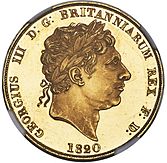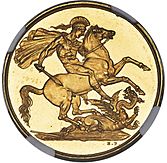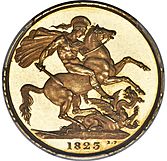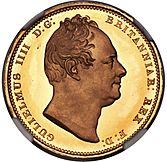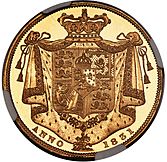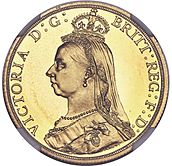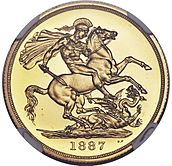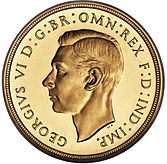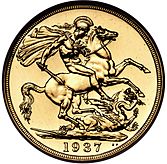Double sovereign facts for kids
| United Kingdom | |
| Value | £2 |
|---|---|
| Mass | 15.976 g |
| Diameter | 28.40 mm |
| Composition | .917 gold (22 carat) |
| Gold | 0.4708 troy oz |
| Years of minting | 1820, 1823–1826, 1831, 1887, 1893, 1902, 1911, 1937. 1953, 1980, 1982–1983, 1985, 1987–1993, 1996, 1998, 2000, 2002–present |
| Mint marks | S (1887 and 1902 only) |
| Obverse | |
 |
|
| Design | Reigning British monarch (Elizabeth II shown) |
| Reverse | |
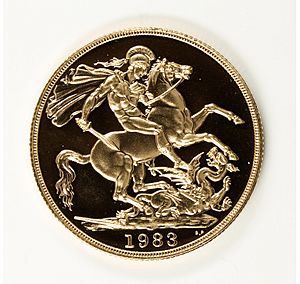 |
|
| Design | Saint George and the Dragon |
| Designer | Benedetto Pistrucci |
| Design date | 1817 (first used on double sovereign in 1820) |
The double sovereign is a special gold coin from the United Kingdom. It is worth two pounds sterling, or £2. For a long time after it first appeared in 1820, it was rarely made. It was not often used as everyday money.
Today, the double sovereign is mostly a coin for collectors or for its gold value. The Royal Mint has made it almost every year since 1980. The front of the coin usually shows the current king or queen. The back often features a famous design by Benedetto Pistrucci of Saint George and the Dragon.
The first double sovereign was made in 1820. It showed King George III. However, this coin was never used by the public. It was more like a test coin. For the next 150 years, these coins were usually made to celebrate a new king or queen. They also marked when a new picture of the monarch was put on coins. Most of these were special "proof coins," made perfectly for collectors. The coin was only made for general use in four years. Because of this, it is rare to find a double sovereign that looks worn from being used as money.
Since 1980, the Royal Mint has sold the double sovereign to coin collectors. In some years, the Royal Mint did not make a double sovereign. Instead, they made gold versions of special £2 coins for their gold proof sets.
Contents
How the Double Sovereign Started
After the Napoleonic Wars, the British Parliament decided to use the gold standard. This meant the value of the pound was set by a certain amount of gold. Most people in Parliament wanted a coin worth twenty shillings. This was instead of the old guinea, which was worth twenty-one shillings. However, the law did not say which coins the Mint should make.
A group of advisors called the Privy Council suggested making gold coins. These would be worth ten shillings, twenty shillings, two pounds, and five pounds. King George, Prince Regent agreed to this idea in 1816. The twenty-shilling coin was named the sovereign. This was an old name brought back, maybe by coin experts. The sovereign and half sovereign coins first came out in 1817. But the two larger coins, the two-pound and five-pound pieces, were not made yet. Before this, since 1754, no coins worth more than a guinea were made for everyday use. People used bank notes for larger amounts of money.
The famous Saint George and the Dragon design was suggested for the sovereign. It was created by Benedetto Pistrucci. He based it on a small carved artwork he had made. Sir Joseph Banks also told William Wellesley-Pole, who was in charge of the Royal Mint, to use Pistrucci's design.
In late 1819, Pistrucci was asked to prepare designs for the double sovereign and the five-pound coin. This happened possibly because King George III was very ill. Some thought it was a race to finish the coins before the king died. However, later research showed the king died before the new coins were ready.
First Double Sovereign Design
The 1820 double sovereign was designed by Pistrucci. It shows the king's head facing right. Around his head, it says in Latin: "George III by the grace of God king of the Britains, defender of the faith." The year is also there. The back of the coin shows Pistrucci's George and Dragon design. This design first appeared on the sovereign in 1817. Pistrucci's initials are at the bottom right. The edge of the coin has a Latin phrase: "An ornament and a safeguard; sixtieth year of the reign." Only about 60 of these coins were made.
In 1823, Pistrucci's George and Dragon design was used again for the double sovereign. The front of the coin showed the new king, George IV. This portrait was made by Jean Baptiste Merlen. Pistrucci refused to make the king's portrait himself. The coin had a similar Latin phrase around the king's head. The date was moved to the back of the coin. The edge inscription was the same as the 1820 coin, but it said "fourth year of the reign."
The double sovereigns made in 1824, 1825, and 1826 had a smaller head of the king. This was designed by William Wyon. The front said: "George IV by the grace of God..." and the date. The back showed a crowned shield. It said: "King of the Britains, defender of the faith." The 1824 coin had an edge inscription. The 1825 coin had no edge inscription. The 1826 coin had a similar edge inscription. Out of the four George IV coins, only the 1823 one was made for general use. The others were special proof coins.
In 1831, a proof double sovereign was made. This was part of a set of new coins for King William IV. The front of the coin showed the king's head facing right. It was designed by Wyon. The Latin phrase said: "William IV by the grace of God king of the Britains, defender of the faith." The back, by Merlen, showed a crowned shield. It said: "year 1831." This coin had no inscription on its edge.
Victorian and Early 20th Century Coins
After 1831, the double sovereign was not made again until 1887. We don't know why it wasn't made in 1839 or 1853. Experts say this long gap shows how little the two-pound and five-pound coins were used in everyday life during the Victorian era. Few double sovereigns found today look like they were used as money. The only ones that show wear are from the four years they were made for general use: 1823, 1887, 1893, and 1902.
In 1887, the double sovereign was part of the Jubilee coinage. This celebrated Queen Victoria's 50 years on the throne. The front showed Queen Victoria. The back had Pistrucci's George and Dragon design. This coin was available in two types: regular coins and special proof coins. The 1887 coin is considered the most popular double sovereign. Many of them were made: over 91,000 regular coins and 797 proof coins. The front of the coin said: "Victoria, by the grace of God, queen of the Britains, defender of the faith." Not everyone liked Pistrucci's design. Some thought it was strange that Saint George was not wearing much clothing.
In 1887, some special dies (tools for making coins) were sent to the Sydney Mint in Australia. These dies had an "S" mark. The Sydney Mint probably only made coins when asked. Very few double sovereigns were requested there. After the Sydney Mint closed in 1926, its equipment went to the Melbourne Mint. A few more coins were made there using the old 1887 dies. Only about 28 of these 1887-S double sovereigns are thought to exist.
Later Victorian and Edwardian Issues
The Jubilee coins were replaced in 1893. The new double sovereign had a different portrait of Queen Victoria on the front. This was designed by Thomas Brock. The back still had Pistrucci's design. This coin was also made in regular and proof versions. The inscription on this coin was longer. It said: "Victoria by the grace of God, queen of the Britains, defender of the faith, empress of India." Queen Victoria had wanted her title "Empress of India" on the coins since 1888. So, "IND IMP" (short for "Empress of India") appeared on the 1893 coin.
After Queen Victoria died in 1901, people tried to keep the coin designs similar. The gold coins, including the double sovereign, kept the same back design. These gold coins became legal money on January 1, 1902. The front of the coin showed Victoria's son, King Edward VII. This portrait was by George William de Saulles. The front inscription said: "Edward VII, by the grace of God king of all the Britains, defender of the faith, emperor of India." The words "of all" were added to recognize the help from the British Empire during the Boer War. These words were last used on British coins in 1953. The double sovereign was only made in 1902 during Edward's reign. A very small number were also made at the Sydney Mint that year.
Double sovereigns dated 1911 were made for King George V's coronation. These were part of special proof sets. For some reason, no regular coins were made that year. This was the only time double sovereigns were made during his reign. These coins had a portrait of King George by Bertram Mackennal. They used Pistrucci's design on the back. The inscription was the same, but with King George's name.
After King George V died in 1936, new coins were planned for his son, King Edward VIII. The new king wanted his profile to face left, like his father's. This would break a tradition of changing the direction with each new king or queen. After much discussion, Edward got his way. Test coins were made with his left-facing portrait. The Pistrucci design was used for the double sovereign. However, King Edward gave up his throne in December 1936. This stopped the coin preparations. Edward later asked for a set of these test coins, but his brother, King George VI, refused. The inscription on Edward's double sovereign was similar to the previous reign. A similar change was made for George VI. His double sovereign has a left-facing portrait and the Pistrucci design. This coin was only made in 1937. It was part of the coronation proof sets.
Elizabeth II and Charles III Coins
The reign of Queen Elizabeth II saw a change in how gold coins were made. A small number of gold £2 coins were made in 1953. These coins were not given to the public. They were placed in museums and the Royal Collection. No more £2 gold coins were made until 1980. The 1953 coins had an inscription that said: "Elizabeth II by the grace of God queen of all the Britains, defender of the faith." After 1953, the words "of all the Britains" were removed. This was to recognize the changing British Commonwealth, which now included some republics.
The Royal Mint realized that people wanted to collect sovereign coins. So, they started selling them to collectors for more than their gold value. Since 1980, the double sovereign has been made most years.
- Coins from 1980 to 1983 used a portrait of Elizabeth by Arnold Machin.
- Coins from 1985 to 1996 used a portrait by Raphael Maklouf.
- Coins from 1998 to 2015 used a portrait by Ian Rank-Broadley.
Most of these coins had Pistrucci's George and Dragon design on the back. In 2009, this design was improved to show more details of the dragon.
No double sovereigns were made in some years, like 1986, 1994, 1995, 1997, 1999, or 2001. In those years, a gold version of a special commemorative £2 coin was put in the gold proof sets instead. In 1989, the usual designs were replaced with a special design. This design looked like the very first English sovereign coin from 1489.
Special Designs and New Monarchs
Special designs were sometimes used instead of Pistrucci's.
- In 2002, for Elizabeth II's Golden Jubilee, a crowned shield design was used.
- In 2005, a more modern George and Dragon design was used.
- In 2012, for Elizabeth II's Diamond Jubilee, another modern George and Dragon design was used.
Starting in 2015, a new portrait of Elizabeth by Jody Clark was used on the front. In 2016, some coins had a different portrait by James Butler. In 2017, a version with the original 1817 sovereign design was made. This celebrated 200 years of the modern sovereign.
In 2022, the Royal Mint made double sovereigns with a new design on the back. This design showed the Royal Arms. This was to mark Queen Elizabeth II's Platinum Jubilee. Later that year, after Queen Elizabeth II died, the Royal Mint made memorial coins. These included the double sovereign. They had a Royal Arms design on the back. The front showed the first coin portrait of Elizabeth's son, King Charles III. This portrait was by Martin Jennings. The front also said: "Charles III by the grace of God king, defender of the faith." In 2023, a double sovereign was made to celebrate the coronation of Charles III. The front had a crowned portrait of the king. The back had the classic Pistrucci George and Dragon design.


